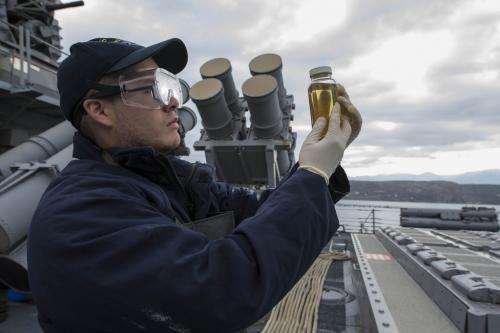“Therefore, all chlorine in solid fuels can be captured and quantified using this improved Eschka method,” Prof Wu says. Credit: Commander, U.S. Navy
Researchers have developed a new approach based on an old method of determining chlorine content in solid fuels, an important advance that could improve fuel utilisation.
The scientists from Curtin University's Department of Chemical Engineering investigated the standard process for determining the chlorine (Cl) content in solid fuels, known as the Eschka method.
Professor Hongwei Wu says the quantification of Cl in solid fuels requires a method to convert the Cl into a form which can be subsequently captured and quantified using analytical instruments.
"The Eschka method is an old but widely-used process to do that. Chlorine in solid fuel is released when the sample is heated up to 675 °C," he says.
"The released chlorine is then captured by the Eschka flux which is subsequently dissolved in acids to prepare a Cl-containing solution for quantification using instruments."
However, they have found the Eschka combustion process significantly underestimates the Cl contents in some low-rank solid fuels, particularly biomass, due to the escape of Cl with flue gas.
"We conducted many experiments and found that the Eschka method worked well for coals" Prof Wu says.
"However, when applying this method to low-rank solid fuels such as biomass, it turned out that the released chlorine cannot be completely captured by the Eschka flux."
"We started looking at a new method based on the Eschka method, what we term the "improved Eschka" method [and] that would be able to recover the escaped Cl in the flue gas for quantification."
Recapturing the escaped chlorine
The researchers have employed a flue gas re-combustion process to convert the escaped Cl into gaseous hydrogen chloride HCl(g) which is then captured using a sodium hydroxide (NaOH) solution.
The Cl in the solution is readily quantifiable using instruments.
Generated from the Eschka process at a relatively low temperature (675 °C), the flue gas is free of other metallic species (e.g. Na, K) so that its re-combustion avoids the loss of Cl in the forms of metal chlorides (e.g. NaCl, KCl).
"We analysed not only the part of chlorine that can be captured by the conventional Eschka method, but also any chlorine that is escaped with the flue gas," Prof Wu says.
"Therefore, all chlorine in solid fuels can be captured and quantified using this improved Eschka method."
Researchers say the improved Eschka method can accurately quantify Cl in a range of solid fuels studied (e.g. a mallee bark, a Victorian brown coal), with a small relative standard error (±2 per cent) and a low limit of quantification (0.015mg/g fuel, dry basis) under present experimental conditions.
More information: Muhammad Usman Rahim, Xiangpeng Gao, Hongwei Wu, "Determination of chlorine in solid fuels using an improved Eschka method," Fuel, Volume 129, 1 August 2014, Pages 314-317, ISSN 0016-2361, dx.doi.org/10.1016/j.fuel.2014.03.070.
Provided by Science Network WA























